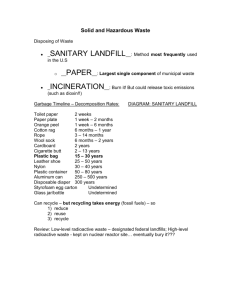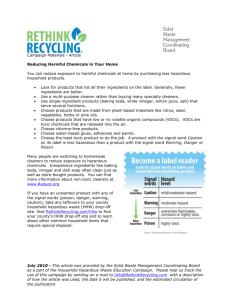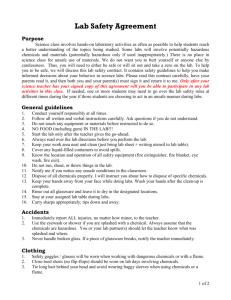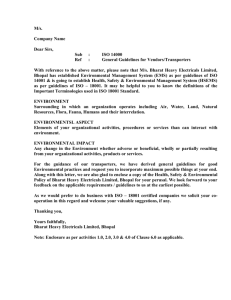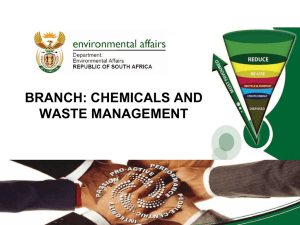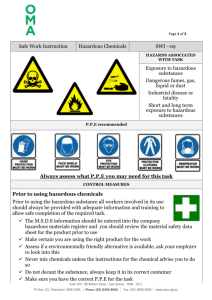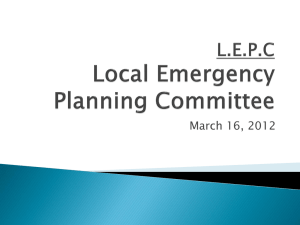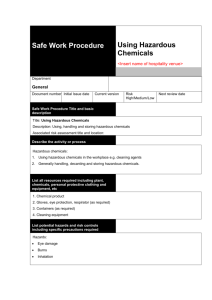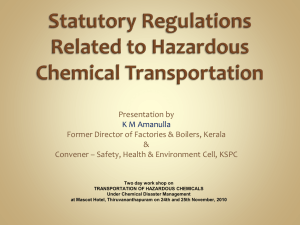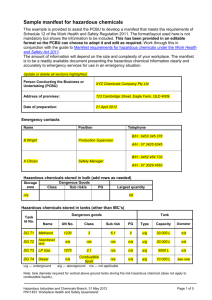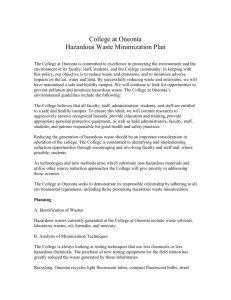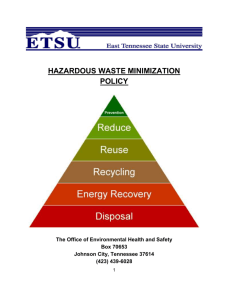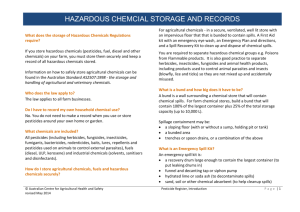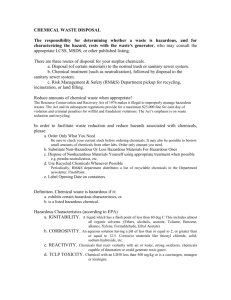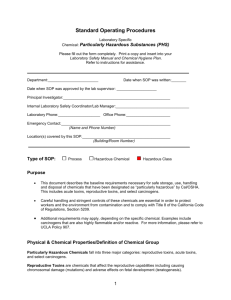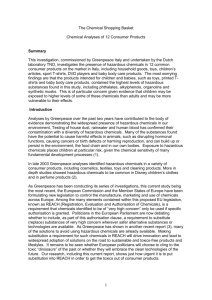LESSON: HAZARDOUS CHEMICALS IN YOUR NEIGHBORHOOD
advertisement
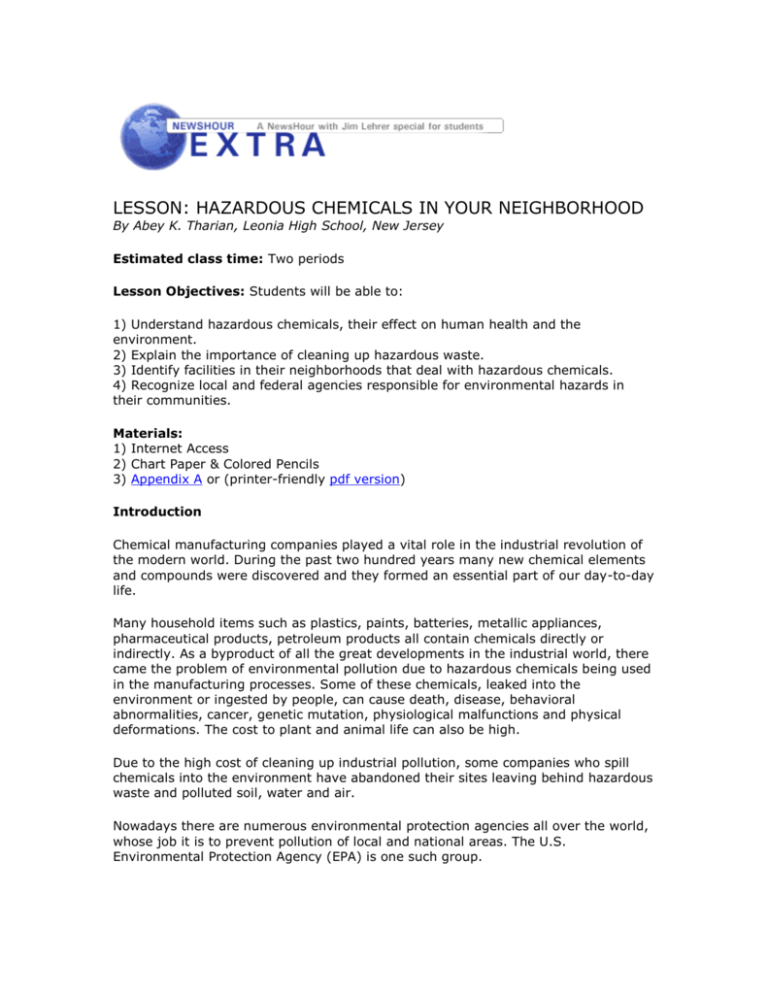
LESSON: HAZARDOUS CHEMICALS IN YOUR NEIGHBORHOOD By Abey K. Tharian, Leonia High School, New Jersey Estimated class time: Two periods Lesson Objectives: Students will be able to: 1) Understand hazardous chemicals, their effect on human health and the environment. 2) Explain the importance of cleaning up hazardous waste. 3) Identify facilities in their neighborhoods that deal with hazardous chemicals. 4) Recognize local and federal agencies responsible for environmental hazards in their communities. Materials: 1) Internet Access 2) Chart Paper & Colored Pencils 3) Appendix A or (printer-friendly pdf version) Introduction Chemical manufacturing companies played a vital role in the industrial revolution of the modern world. During the past two hundred years many new chemical elements and compounds were discovered and they formed an essential part of our day-to-day life. Many household items such as plastics, paints, batteries, metallic appliances, pharmaceutical products, petroleum products all contain chemicals directly or indirectly. As a byproduct of all the great developments in the industrial world, there came the problem of environmental pollution due to hazardous chemicals being used in the manufacturing processes. Some of these chemicals, leaked into the environment or ingested by people, can cause death, disease, behavioral abnormalities, cancer, genetic mutation, physiological malfunctions and physical deformations. The cost to plant and animal life can also be high. Due to the high cost of cleaning up industrial pollution, some companies who spill chemicals into the environment have abandoned their sites leaving behind hazardous waste and polluted soil, water and air. Nowadays there are numerous environmental protection agencies all over the world, whose job it is to prevent pollution of local and national areas. The U.S. Environmental Protection Agency (EPA) is one such group. In 1979 the EPA estimated that there were thousands of inactive and uncontrolled hazardous waste sites in the country that could pose a serious risk to public health. Chemical spills posed another danger. Environmental damage resulting from such spills can result in massive death of fish, destruction of wild life, air pollution and loss of livestock by contamination of drinking water. Spills also resulted in loss of life and direct threat to human health from toxicity, fires and explosions. Some of the examples of environmental damages due to hazardous chemicals are cited below. 1) Love Canal, Niagara falls, New York Hooker Chemical Company used this Canal during 1940s and 1950s to dump 82 different chemical compounds, 11 of them suspected carcinogens. In 1953 the canal was covered with earth and sold to the city for one dollar. It was a bad buy. Through the 1960s and 70s, residents, whose homes were built above the polluted canal, reported odors and incidents of chemical residues seeping in to their basements and lawns. The contamination caused miscarriages, birth defects, respiratory ailments, and cancer. 2) Bridgeport, New Jersey In 1977 sparks from a welder torch ignited an accumulation of chemicals including benzene, toluene and PCBs (Polychlorinated Biphenyls) at a waste storage facility. Six people died and 35 were hospitalized. 3) Toone, Tennessee (1978-79) A chemical company dumped pesticide waste into a landfill. Six years after the landfill is closed, the drinking water is found contaminated and the city of Toone is required to provide an alternative water supply to residents living within three miles radius. 4) Riverside, California (1978) Erosion of the retaining dam for a waste pit threatened eight million gallon torrent of waste materials including DDT (Dichloro Diphenyl Trichloroethane), nickel, lead, chloroform and trichloro ethylene. In order to deal with the hazardous waste problem, Congress proposed the creation of a "Superfund" - a multi-million dollar federal toxic waste clean-up initiative. On December 11, 1980 President Jimmy Carter signed the new Comprehensive Environmental Response, Compensation, and Liability Act (CERCLA) or "Superfund." The responsibilities of the Superfund program were to: Determine the number of sites where potentially significant contamination existed; Assess who was responsible for the waste; Develop a structure to enforce CERCLA; Determine the contaminants and quantities dumped; Research where the contaminants were coming from; Calculate the actual human exposure to contaminants and the potential health risks; and Create technologies to remove or control contaminants. Questions 1. What are hazardous chemicals? Write 5 examples 2. When did the EPA begin its Superfund program? What were the reasons for its establishment? 3. What are the responsibilities of the Superfund program? 4. What were the environmental effects of Love Canal tragedy? Who was responsible for the tragedy? 5. What are the four important pathways used by Hazard Ranking System (HRS) to score a hazardous site? 6. What are the health effects of PCBs? 7. What are the sources of mercury contamination? What are its health effects? 8. What chemical contaminants are present in dry cleaning agents? What are the potential health effects? 9. List five health effects of pesticides? 10. Where should you report environmental damage or health effects due to any facility dealing with hazardous chemicals in your neighborhood?
